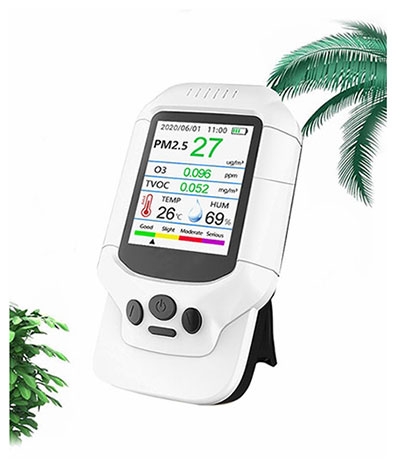Buying an air quality monitor is an important decision, whether you are an individual, a home, a business, or a government agency. A good air quality monitor can provide accurate data to help you better understand and manage air quality issues. In this buying guide, the sisco store will detail how to choose the right air quality monitor for your needs.
Determine the Need
- Purpose: The main purpose of purchasing the air quality monitor, whether it is to monitor indoor air quality in the home, or for use in the workplace, school, or environmental research.
- Monitoring Parameters: Common parameters include particulate matter (PM2.5 and PM10), nitrogen dioxide (NO2), carbon monoxide (CO), ozone (O3), sulfur dioxide (SO2), and so on.
- Data Accuracy: The accuracy of the data required, some applications require high accuracy while others can accept relatively low accuracy.
- Data Logging: Whether the air quality monitor needs to be able to log data for long-term analysis and trend observation.
- Portability: Whether a fixed installation air quality monitor is needed or a portable air quality monitor is required for mobile monitoring.
Choosing the Right Type
Choosing the right type of air quality monitor for your needs is critical.

- Portable Air Quality Monitor: Suitable for personal and mobile monitoring, usually smaller and lighter. Portable air quality monitors can provide instantaneous data but are not usually suitable for long-term spot monitoring.
- Stationary Air quality Monitors: Suitable for applications that require long-term, spot monitoring, such as industrial areas and urban monitoring stations. Stationary air quality monitors usually have high accuracy and stability but are more expensive.
- Outdoor Air Quality Monitor: Used for monitoring pollutants in the atmosphere, usually for environmental research and urban planning. Outdoor air quality monitors usually require professional installation and maintenance.
- Indoor Air Quality Monitors: Used to monitor indoor air quality within a home or workplace, including parameters such as particulate matter, carbon dioxide, temperature, and humidity. Indoor air quality monitors can help you improve your indoor environment.
Focus on Key Features
- Precision and Accuracy: Check the specifications of the air quality monitor to determine the precision and accuracy of the parameters it measures.
- Monitoring Range: Make sure the measurement range of the air quality monitor is suitable for your application. Different monitors may have different measurement ranges.
- Response Time: Understand the response time of the air quality monitor, especially for applications that require immediate data, such as indoor air quality monitoring.
- Data Logging Capabilities: If long-term data logging and trending are required, make sure the air quality monitor has the appropriate data storage capabilities.
- Calibration and Maintenance: Understand the calibration requirements and maintenance intervals of your air quality monitor to ensure data accuracy.
- Connectivity: Some air quality monitor have Wi-Fi or Bluetooth connectivity to transfer data to mobile devices or the cloud for easy data management and remote monitoring.
- Power Requirements: Understand the power requirements of your air quality monitor to ensure you can provide the power supply you need.
- User-friendliness: Choose an good air quality monitor that is easy to use and configure to minimize operation and data interpretation.
Brand and Supplier
It is important to choose reliable brands and suppliers who can provide quality assurance and after-sales support. Check customer reviews and recommendations to find reputable brands. Find out the warranty policy of the air quality monitor and the support services of the supplier. This will ensure that you can get the necessary help and repairs after your purchase. sisco shop has been a provider of test and measurement equipment research for over 10 years. Our goal is to provide high-quality test and measurement equipment at the most affordable prices. We offer a wide range of indoor air quality monitors, so if you are interested, feel free to click and visit us.
Ensure that the air quality monitor complies with relevant international or industry standards and has the necessary certifications. Consider whether the air quality monitor supports additional modules or sensors to extend its functionality in the future. Check the monitor's availability and delivery time to ensure that you will be able to get the equipment on schedule.
Finally, consider your budget. Prices for different types of air quality monitors and brands vary widely, so make sure your budget is sufficient to cover your needs. Keep in mind that lower-priced monitors may not always provide the accuracy and reliability needed, so don't just look at price, but consider performance and quality together.
Buying an air quality monitor requires careful consideration of your needs, monitor type, key features, brand, and budget. Choosing the right monitor will help provide accurate air quality data to improve health, environment, and quality of life. We hope you find this buying guide helpful and that it enables you to make an informed purchasing decision.

